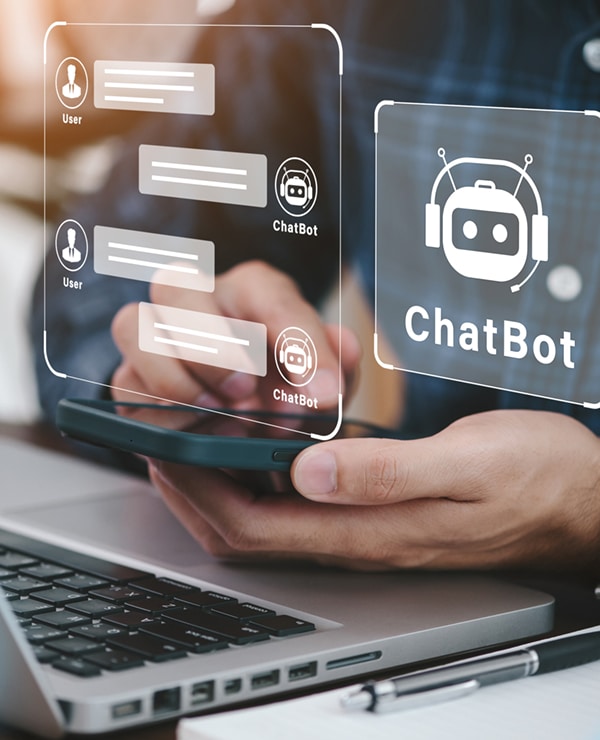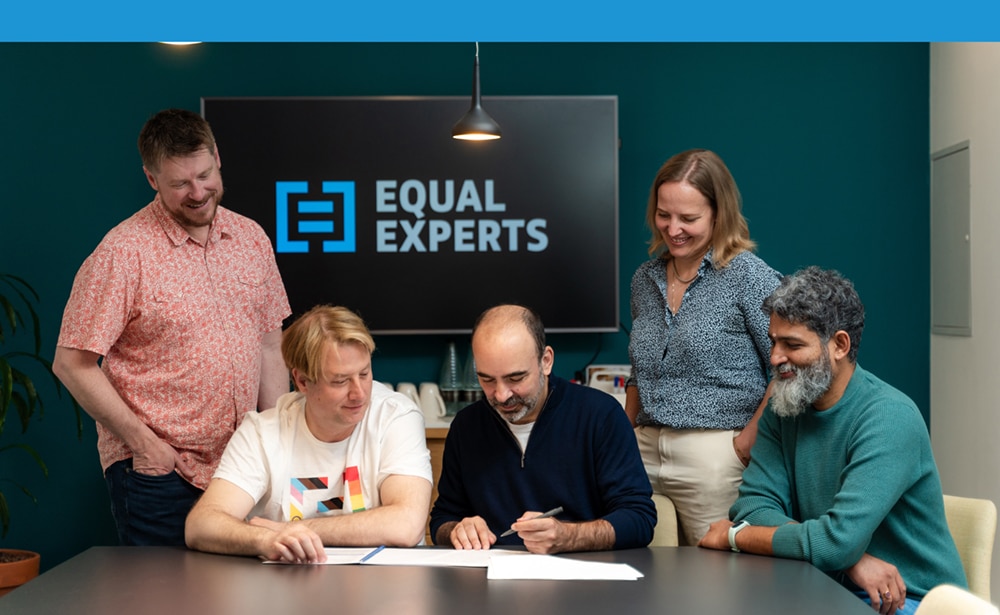Sree Balakrishnan is Director of Product & Innovation at Travelopia, the world’s leading collection of experiential travel brands. He is also a founding member of the Equal Experts Network Trust, helping to shape and evolve the company’s long-term strategy. We recently caught up with Sree at the Equal Experts Annual Conference in London and took the opportunity to chat about his experience of adopting AI in the SDLC, and what advice he’d give to other tech leaders starting on their AI journey.
How are you currently using AI in the SDLC?
The first thing we did with GenAI in the SDLC was comparing the work done by the traditional development team versus the AI-assisted team. What we found was that the GenAI team was able to deliver something in six weeks, compared to the three months we estimated it would take the traditional team.
I thought if we could really save 50% on development time, even during a learning cycle, then there’s something here.
From there, we chose six projects, three greenfield and three brownfield (taking an existing module and redoing it). We took them from idea to execution completely using GenAI, and this felt like a good sample size to feel confident in changing the SDLC.
Today three of those modules have gone live. The results suggest we can get modules live faster, cheaper and better – in one case the estimated SDLC time was six weeks using traditional methods, but we got it done in three days.
We’re still learning about the maintenance of those projects and figuring out what that looks like, but the real learning is that SLDC and GenAI are easy compared to the change management efforts we had to take with our own teams.
What tools are you using?
Every time we try to create a budget for tooling, it changes – nobody can identify which tool works best for them because it’s being updated ten times a day, and new models emerge that can code faster (or reason faster) than the others. The same applies to any tools or LLMs. We are testing all of them: Cursor, Windsurf, Copilot, and also using LLMs from major players like Google, Claude, ChatGPT, etc. It’s too early to finalize the tool or LLM stack. So, we decided to try a few options and finalize the tooling and LLMs in a few quarters.
The way that we work in SDLC has changed, and we no longer spend a lot of time designing or coding (you heard it right). With AI, the front end design and coding process is quicker and we can do in a few hours what used to take days or weeks. Biggest change so far – Our senior guys have stopped coding and now they only review the code generated by LLM’s. Finally understood the meaning of “Build the things that build things”.
What can you share about your journey from starting GenAI to where you are today?
I think the adoption of AI is following the hype cycle, which was last year. We got to the lowest point in December, then restarted the journey with Equal Experts in February 2025. By April, I’d say that I started to think really about how to retrain my team to make this stuff work?
One of the biggest learnings is that this isn’t an add-on in anyone’s life. My general recommendation is that you start with the assumption that you’re going to be redundant in a year’s time, and you should retrain yourself. If you survive the retraining then you’re probably around for the long-term and if not, you need to identify a different role. It’s very challenging, but it’s been a big learning for me.
The second thing I’ve learned is that the way we write code using AI is fundamentally different. Yes, it saves time, but one of the reasons for that is coding in what I call ‘dark mode’. So this isn’t about generating code then coming back two weeks later to answer a question – it’s answering questions the AI asks, in real-time. As an organisation we need to sit down as tech and business people – to answer questions in real time because to an extent, there’s no more writing code, it’s just answering those questions.
Third, just because GenAI generates something doesn’t mean it’s accurate. You absolutely need a human in the loop to review the code, and we underestimated how much change management that involves. We have engineers who are proud of writing code, they’ve been doing it for 20 years, and now you’re almost saying we don’t care about your coding skills, I care how well you can review ai-generated code. It can be like a slap in the face.
How have you approached change management?
We are definitely still figuring it out but you have to be open and honest that it’s a new way of doing things.
When we built our AI module we figured out the infosec wasn’t well thought through, and we needed a smart engineer to understand what we had built. You do still need engineering capability, just at a higher level, not for writing code any more. We can give people the ambition to get involved higher in the value chain.
We’re definitely still figuring it out, but I think it’s about mindset – the people with the mindset of adopting Gen AI will survive. The other people will still have jobs, because there are always going to be mainframe jobs and so on. But people who are ambitious, who want to work in software, if AI isn’t part of your arsenal, I don’t think you are in a good place.
What advice would you offer other senior technology leaders facing these challenges?
One thing that’s really helped us is to approach AI with an experimental mindset. That’s important because experiments are allowed to fail!
Many organisations are worried about AI, and worried about failing. If that is your organisation, then you can wait. Just because you adopt AI last doesn’t make you a bad person. You wait one or two years until it matures, and then adopt. What is critical is only that AI is part of your journey over the next two to four years.
But here’s the flipside. It’s only a matter of time before your finance department comes knocking, asking if you know how to use GenAI to improve your productivity. Now imagine you delay all this by one year, and you need a year to figure it out – that means you’re going to be doing all that learning under pressure.
By adopting AI today, you have an opportunity to learn before it’s highly pressurised. Senior leaders are still figuring out the impact of GenAI, but you can upskill yourself. Accept the vulnerability that comes with saying, I can figure this out if you let me try, and so what if I fail? Isn’t that a better approach than it being one year later and you’re suddenly faced with having three months to figure this all out?
How do you think AI adoption has affected roles, responsibilities and skill sets within your engineering teams?
I think we’re now seeing a new, particular role that I call ‘product engineer’.
Rather than just being an engineer or a business analyst we need more pragmatic engineers. So the business analyst needs to shift left and learn tech, while the engineer needs to shift right and learn product or business mode. The successful pair is someone who knows both engineering and product well.
As an organisation, we’re big fans of pair programming and we don’t think we need it any more. AI is your pair. We were a big lover of Test Drive Development (TDD) but AI can do that as a part of your code cycle. You no longer need separate testing.
I definitely think some roles are going away, and we’ve given ourselves three months to figure out what that looks like. In an extremely optimistic view, I think a three-member team can run our function in a GenAI world, replacing the 12-member team we have currently. But those three people will need to adjust their skills. Overall, we expect to see a 70% reduction in cost, but I prefer to look at it not from a lens of reduction, but from a view of let’s see how the team can learn and adapt.
For me, the biggest aha! moment was my business owner being able to maintain the spec and make changes himself, without the help of my tech team. The way we’re going to manage software delivery is going to change a lot.
How do you see the role of AI evolving in the SDLC, and what strategic shifts should we be preparing for now?
It’s probably too early to comment on what’s happening five years out, but one change that we do need to prepare for is that shift in timescales from a project shifting from six weeks to three days. That’s great but who is thinking about Infosec, and who is thinking about IP and copyrights, and who does this code legally belong to if it’s AI generated?
In two years’ time we’ll be thinking about how AI gets trained better, how do we evolve from the head eating the tail? If everything is AI-generated, and AI is trained by what’s being AI-generated, it’s an unsolved problem. Where does the human generate content, and where does the machine stop?
I think there are loads of legal, data quality and infosec-related issues to be addressed in the SDLC cycle.
I’m hoping that the European regulations will be a good countermeasure to the fast-paced growth of American innovations, and I hope we see healthy tensions between the divergent thinking we have in the world.
One thing I’ve learned working with Phil and his team is how to make AI systems less biased, which we think is our IP now. But this is tricky. Imagine you write a spec and give that spec to different AIs. Each AI will generate different code for the same spec. So how do we make AI more deterministic? If the same spec applied by different LLMs generates slightly different output, who owns the output?
If we put code into a free editor, who owns the code then? How do you ensure that something you think of as your IP isn’t being used as training data? Your Infosec position around AI has to be rock solid. Because one incident could make senior leadership lose focus on all the GenAI and want to go back to the old way of doing things.
What would you do differently in your AI journey, if you could?
I would sit and talk to every team member about our thinking, and how vulnerable we are all in this journey, myself included. I’d tell people that we will figure this out together, and you will have to upskill. I’d spend more time on change management and do it better, if I could reverse time, because I think I got sucked into the hype cycle of ‘I don’t need as many team members’ without realising that actually, you need different type of mindset in team members and you need to take everyone on that journey.
In reality, you might end up with a reduced team, but you might have the same team doing more work, or a team of the same people doing new things, it’s all possible.
One of the reasons I really value the Equal Experts network is that it’s a place I can go and be vulnerable and share my challenges with someone else who’s going through this. Often I’ll find that eight other organisations are going through what we’re going through and it’s comforting to know I’m not navigating this journey alone. It’s become a great backbone.




